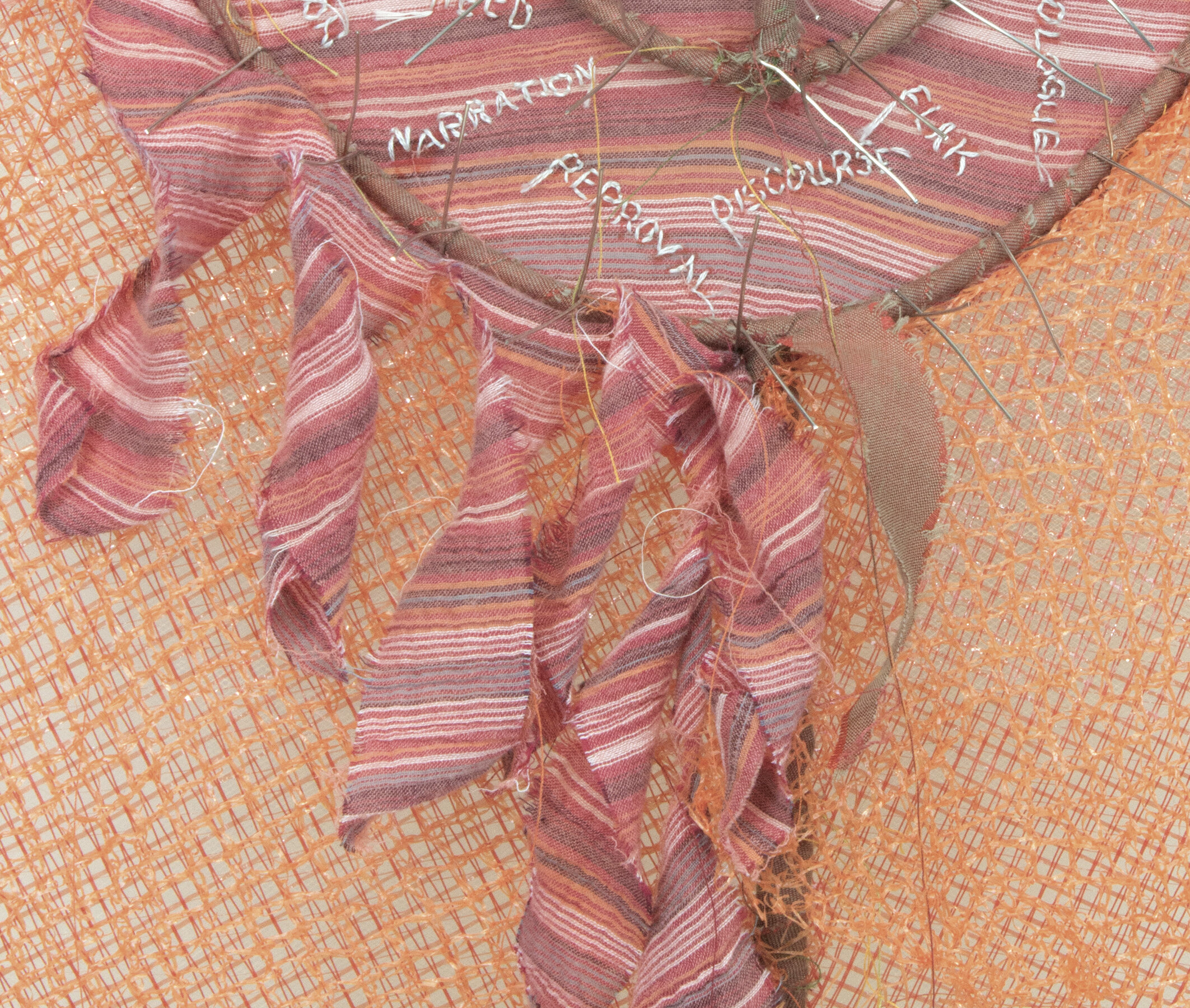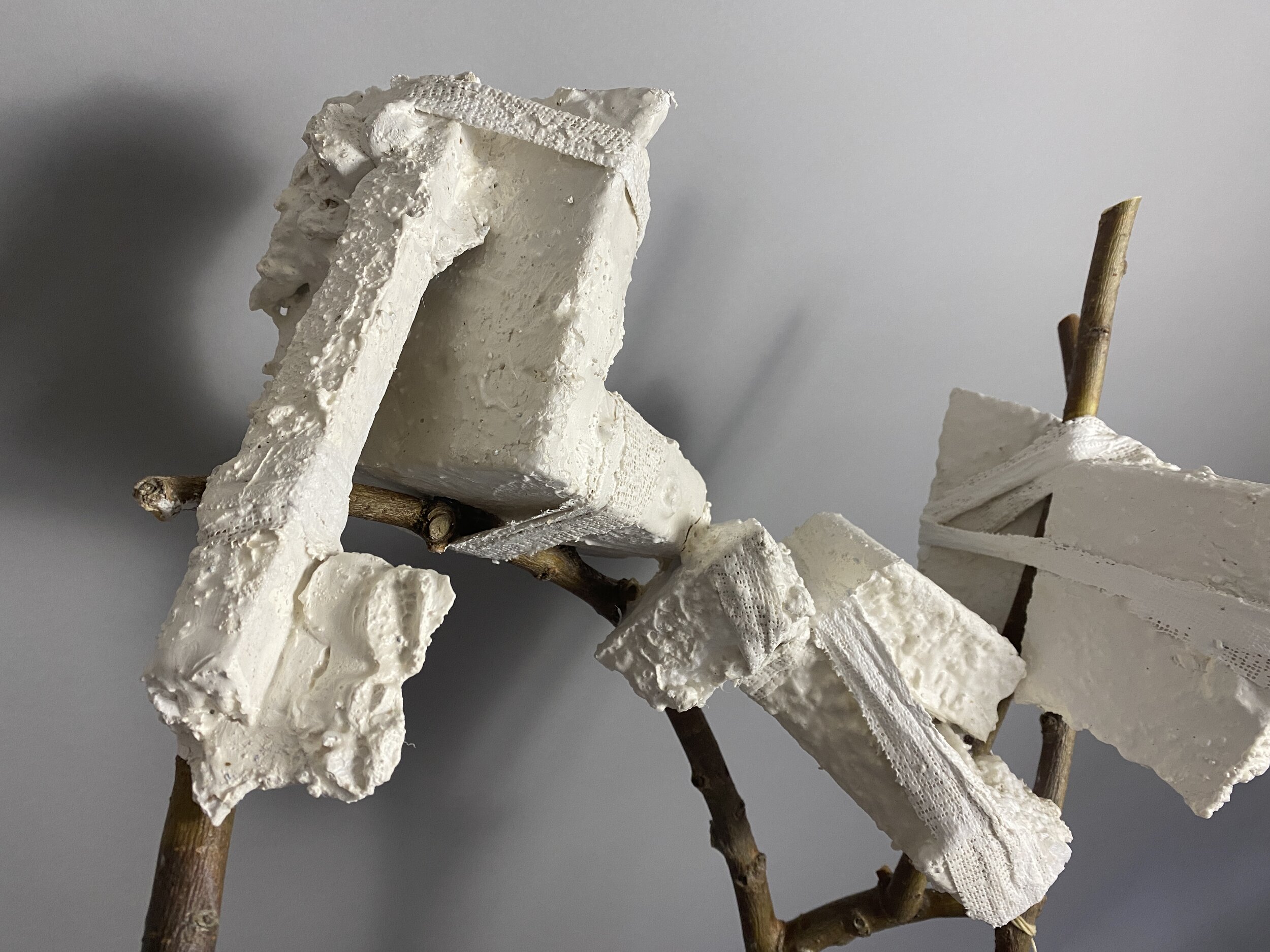Excerpts from a Conversation
We are inspired by the inherent qualities of the materials we choose and use, we exploit those attributes, and recognize/use them for the conceptual weight they bring to our work
The organization of Fountain Street’s main gallery exhibitions take time, planning, and many conversations between paired artists. There is a method to the madness. Connections are made. Themes emerge. Concepts develop. Work is influenced. Outcomes surpass their original intent. It is not an easy process, yet its results are highly effective and fulfilling.
Artists Sylvia Vander Sluis and Virginia (Ginny) Mahoney began the planning process for their 2021 two-person exhibit as soon as the match was made. Meeting almost every two weeks to share, discuss, collaborate and support each other through the collaborative effort.
In June, these two artists take the ‘mainstage’ at Fountain Street when their two-year collaboration “Material Witness” opens. In this post, Sylvia and Ginny share excerpts from a conversation about the choice in exhibition title and their processes.
Sylvia Vander Sluis, Somber Skin (detail), cheesecloth, acrylic, sawdust, string, 80 x 40 inches
Sylvia: What does “material witness” mean to us?
We witness our experience.
We use material to process our experience.
We also witness how material looks and acts, and we respond to that.
We are drawn to, and exploit, the inherent qualities of material.
There is a relationship between the materials we use and what the work expresses. Material also has personal, social, and political associations. These become part of the work’s content, consciously or unconsciously, in the minds of the artist and viewer.
Ginny: We are inspired by the inherent qualities of the materials we choose and use, we exploit those attributes, and recognize/use them for the conceptual weight they bring to our work. I think that is why we both responded to this title.
Virginia Mahoney, Social Distance Soliloquy (detail), copper, reclaimed fabric, reclaimed vegetable net, 28 x 16 x 6 inches
Ginny: I’ve been thinking about what “Material Witness” means in my studio practice. I do small stitching projects that are little archives of materials but may become something else as they evolve. These little “unimportant” pieces are experimental, and they let my mind wander. They are a way to use every last bit of material.
Regarding the way material qualities can influence concept, as I wrapped strips of fabric around the armature for a piece, the fraying of the fabric as I stretched it around the wire armature struck me as a metaphor for our tightly wrapped lives coming apart.
Sylvia Vander Sluis, The Beauty and the Pain, with apple crate boards, 16 x 16 x 16 inches
Sylvia: This morning, I was thinking about the kind of environment I want to build in the gallery for my work. I envisioned groups of objects that have an affinity with each other. Using conventional pedestals does not fit their character. I wanted to emphasize the contingent nature of the materials by placing the objects on supports made of cast-off materials, such as wooden pallets. The viewer’s experience would be like discovering a series of found objects, albeit designed objects. In the afternoon, I ended up salvaging lots of broken apple crates at a local farm store.
Ginny: What made you take the apple crates? Did you imagine their use when you saw them?
Sylvia: I originally thought of wooden fruit crates, but found they aren’t used anymore in grocery stores. I knew immediately the crates were perfect because of their weathered color and texture.
Virginia Mahoney, Blinders (detail), copper, reclaimed fabric, reclaimed vegetable net, thread, 28 x 24 x 12 inches
Ginny: I’ve decided that spikes in the head area of this series emphasize the scariness of trying to isolate/cut oneself off/defend against a threat, and the harsh reality or side effects of being shut off. They serve as a warning of sorts. I’ve been working on what words to embroider on each piece as well.
Sylvia: Language seems to play a big part in your process. You describe how material acts, then find a verbal metaphor for it?
Ginny: Language fascinates me. It’s ambiguous, inexact, confusing, indefinite, poetic. And yet, we depend upon it so much. I discover metaphor in the act of working with a material, and the visual/tactile result of its behavior in reaction to my action. I discover words that resonate when I’m scrolling through Word Hippo, or I just come across a word and feel its affinity with a particular work. Making word lists, hunting for synonyms and their variations is part of my process to further develop the conceptual strength of a piece.
Sylvia Vander Sluis, Relationship (detail), willow branches, plaster gauze, gravel, Styrofoam, 54 x 36 x 20 inches
Sylvia: What do my objects desire? They want to:
Be mysterious.
Lead the viewer into imaginative places.
Be suggestive without being definitive.
Be of their own world.
Show a state of flux.
Have complexity.
Be private.
Suggest a journey.
Ginny: I love this question. I think I’m always asking it indirectly in my thinking process. It reminds me of what I hear authors of fiction say about their characters. And your answers are great guidelines for decision making about work in progress. What made you ask and answer it? Was it out of a need for clarification when working on something in particular?
Sylvia: The question was suggested in a critique group I am in. I like how the question gets me away from thinking about creation as a reflection of my psychology. Instead of asking “why” questions – why am I doing this, why am I choosing these materials? -- it is more interesting to ask “what” questions – what are the materials doing, what are the materials communicating? For example, what conceptual themes are the materials communicating? “What” questions can lead to a much richer conversation and additional insight into the character of the work.
As a case in point, during this exercise I wrote that my objects wanted to suggest a journey. I then started imagining ways to reflect that idea in the exhibit. When I saw the broken apple crates, I recognized a way to do it. The pieces could be arranged like a boardwalk.
Ginny: This is a terrific description of how ideas can evolve in reaction to materials.
Virginia Mahoney, Muffle (detail), copper, reclaimed fabric, reclaimed vegetable net, 25 x 20 x 14 inches
Sylvia: Incorporation of experiments and accidents have always been part of your process. Is there something new about the concept of impermanence that has entered your work?
Ginny: I’m not sure yet. But it may be related to my feelings about how the upheaval of the pandemic and other aspects of life in 2020 highlighted the impermanence of our life paths and arrangements. You know, we work so hard to achieve goals, and it really isn’t permanent. I think life is dealing with that constant impermanence and change, which is really the only certainty. Yet we still strive to create balance and stability in our lives. Is that even possible? It’s kind of a crazy loop. I can see all this wondering bubbling up to the surface of my work at some point.
The improvisational aspect of your work gives it a fleeting quality that stays with me, which is ironic, because it feels impermanent and almost breathless. Does it feel that way to you?
Sylvia: Your comment hits home. I have experienced a profound, internal shift in the past year. The individual pieces I create these days are less important than my deeply focused practice. The work itself talks about the importance of transitory, often contradictory, aspects of human life. I am committed to letting both pathos and joy coexist in the work.
This conversation has been fun, and I’ve learned so much more about your process. Thanks!
Ginny: Likewise!






